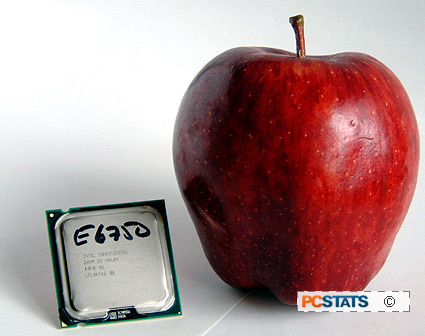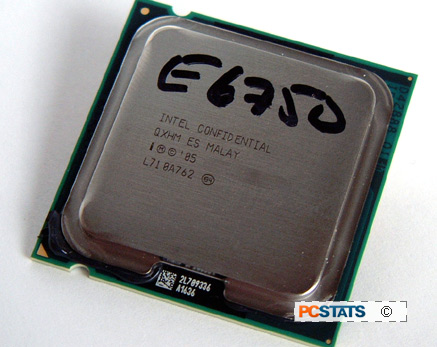 The Intel Core 2
Duo is easily the best desktop processor architecture available on the market.
Team that up with ramped up front side bus speed (now kicking away at 1333MHz),
very very aggressive pricing, average ~65W for CPU energy consumption, and
well... it's no surprise Intel is slaughtering AMD.
The Intel Core 2
Duo is easily the best desktop processor architecture available on the market.
Team that up with ramped up front side bus speed (now kicking away at 1333MHz),
very very aggressive pricing, average ~65W for CPU energy consumption, and
well... it's no surprise Intel is slaughtering AMD.
Officially the Intel Core 2 Duo E6750 is a higher end
processor model, with a default clock speed of 2.66 GHz and 4MB of on-die L2
cache. It's retail price is another mather though, and more in tune with an
entry level CPU. I don't know how Intel can get away with only charging $218 CDN ($206 US, £103 GBP) for the Core
2 Duo E6750... The E6600 cost more than twice this when it was introduced. In
any case, as PCSTATS full set of benchmarks have shown you, the E6750 CPU
really packs in a lot of value! Nice.
On the technological front there is no significant
difference between the Intel Core 2 Duo E6750 and earlier Core 2 Suo versions.
Manufacturing die technology, L2 cache sizes and core architecture remain
identical between the Core 2 Duo E6750 and E6600 which runs on a 1066 MHz FSB.
The new 1333MHz FSB chip simply uses a newer core
stepping and runs on a higher 1333 MHz Front Side Bus. With that said, though if
you want one of Intel's new 1333 MHz parts for yourself, you'll need a new Core
2 Duo compatible motherboard or at least something based on Intel's P35 Express,
G35 Express, G33 Express of nVIDIA's nForce 6 series (680i, 650i) chipsets.
The Core 2 Duo E6750 has a TDP of 65W which is
considerably lower than the old Pentium D's consumed. Total system power draw
tests showed us than an E6750 can be the cornerstone of a more energy efficient
platform, particular when compared to the Pentium D 940 and Athlon64 FX-62 systems which consumed upwards of 168W
each. The Core 2 Duo E6750 system weighed in at 123W.
 Under a
multi-threaded load, the differences in power consumption ballooned. The Intel
Core 2 Duo E6750 CPU system drew 151W with one core loaded, and 163W with both
processing cores stressed. The Pentium D 940 was the worst offender - it managed
230W and 253W respectively for single and dual core loads. Even AMD's Athlon64 X2 5000+ CPU system was poor; consuming 177W
with a single core load and 207W with a dual core load.
Under a
multi-threaded load, the differences in power consumption ballooned. The Intel
Core 2 Duo E6750 CPU system drew 151W with one core loaded, and 163W with both
processing cores stressed. The Pentium D 940 was the worst offender - it managed
230W and 253W respectively for single and dual core loads. Even AMD's Athlon64 X2 5000+ CPU system was poor; consuming 177W
with a single core load and 207W with a dual core load.
The Intel Core 2 Duo E6750 processor really excelled in
all the benchmarks.
Office applications underlined the point that the E6750
is overkill for these kinds of tasks, an economical CPU handles the benchmarks
at almost at the same levels. When it comes to 3D gaming or data crunching
software, nothing else matched the Core 2 Duo E6750 processor! You can tell that
the 1333 MHz FSB made quite a difference, for the 1066MHz FSB Core 2 Duo E6600 had a difficult time keeping pace.
The big question PCSTATS really wanted to answer is
whether the Intel Core 2 Duo E6750 CPU would run better with low latency DDR2
memory or with DDR3 RAM? The latter has a huge amount of memory bandwidth, which
will benefit quad core processors more. Reading between the lines, Intel is
basically trying to lay the foundation for quad core processors, that's why DDR3
is available now. As you saw in the benchmarks, the dual-core Intel Core 2 Duo
E6750 processor runs best with low latency DDR2 memory, there's no reason to
upgrade to DDR3 with this processor.
The coolest thing about the new 1333MHz Intel Core 2 Duo processors
like the E6750 is its overclocking capability! The previous Core 2 Duo CPU
generation could reach 3.4-3.6 GHz without much difficulty, but the new 'G0'
stepping can do even better. The Intel Core 2 Duo E6750 PCSTATS tested was able
to hit a spectacular 3.8 GHz while the stock Intel heatsink. We've already read
reports online of other benchmarkers who have achieved close to 4 GHz on air
cooling!
If you're in the market for a new processor or want to
overhaul your system, now is an excellent time. The 1333MHz FSB Intel Core 2 Duo
E6750 processor is an awesome CPU, and it is dirt cheap for what it can
accomplish on a P35 Express motherboard with nice (affordable) low latency DDR2
RAM!

Find out about this and many other reviews by joining
the Weekly PCstats.com Newsletter today! Catch all of PCSTATS
latest reviews right here.
Related Articles
Here are a few other articles that you might enjoy as
well...
- Intel Core 2 Duo E6600 2.4GHz Processor Review
- AMD Athlon64 X2 4800+ 65nm Processor Review
- Intel Pentium M 740 1.73GHz socket 479 Processor
Review
- AMD Sempron 3600+ 2.0GHz Socket AM2 Processor Review
- Intel Pentium D 940 3.2GHz Dual Core Processor
Review
